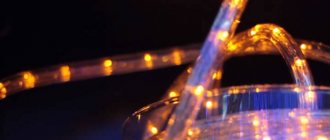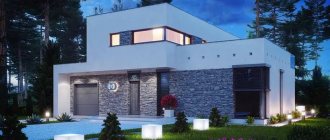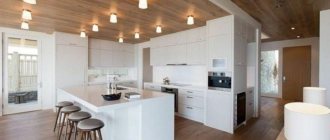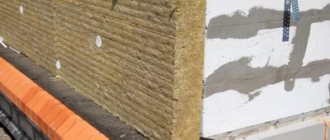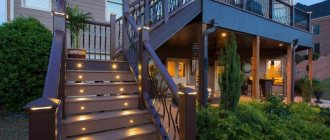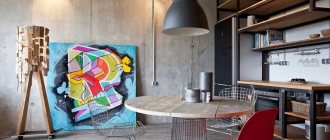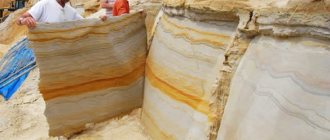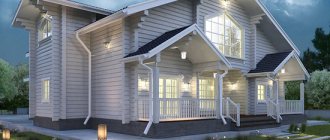In addition to the main outdoor lighting of country houses, decorative lighting is often used: everyday and festive. It can be architectural (for stylish highlighting of building elements) and landscape (for decorating the front area, recreation area and garden). Conventional lighting fixtures and illumination are not suitable for illuminating a private home from the outside. When temperatures change, or in rainy or snowy weather, they can become damaged and unsafe. Recommendations for choosing the right equipment, as well as ideas for fashionable New Year's lighting for country houses, are in our article.
Architectural decorative lighting for a home, tips with photos
Architectural evening and night lighting is used for stylish decoration of facades and roofs of country buildings. With its help, you can advantageously emphasize the architectural features of a building, give it originality and individuality on ordinary days, and literally transform it on holidays.
There are four methods of architectural decorative lighting:
- general flood lighting;
- accent lighting;
- hidden lighting;
- festive illumination.
Flood decorative lighting allows you to effectively illuminate a country cottage or entire house, advantageously highlight architectural features, and draw attention to the beautiful texture of the cladding. To do this, use fairly powerful ground-based and wall-mounted spotlights. The first ones are placed on the ground, near the foundation, the second ones are mounted to the walls, eaves and roof.
With the help of accent (artistic) lighting, you can stylishly highlight the main elements of the facade: windows, doors, attics, balconies, terraces, stairs, balustrades, arches, columns - as well as decorative architectural nuances: pediments, cornices, panels, rustications, rosettes, frescoes and etc.
Accent lighting can be blurred (smoothly emphasizing architectural nuances) and contour (clearly indicating their outlines). This lighting option is often combined with flood lighting. For spectacular accent lighting and a beautiful light pattern, distributed and directional lamps are used, often with light filters.
For hidden lighting, underground type lamps are chosen or they are disguised under protruding architectural elements. Decorative lighting of a hidden type is used if you need to create a stylish lighting motif and draw attention to the most spectacular fragments of the building's facade. Hidden lighting can be static (silhouette, contour) or dynamic (with the ability to control the shades of light, direction and power of light fluxes).
In the festive decor of country houses (usually New Year's), in addition to the main architectural lighting, illumination is used: lamps with adjustable filters, original LED garlands, nets, tubes, laser landscape projectors, LED symbols, figures and inscriptions.
Adviсe:
- When choosing devices for evening decorative lighting, it is important to consider how they will look in daylight. It is better not to use luminaires with long brackets or in too noticeable and massive cases or to carefully disguise them.
- If the windows of the bedrooms and living room overlook the façade, you should avoid flooded decorative lighting. Strong directional light can interfere with rest. Alternatively, you can hang blackout curtains on these windows.
- If you are not confident in your design “talents,” it is better to entrust the matter to a professional. A specialist will help you choose a lighting style, think over a color pattern, decide which architectural details of your country house should attract attention, and which, on the contrary, should be hidden.
- For everyday outdoor lighting of a building, it is advisable to choose not too bright lamps with delicate diffused light. For a festive occasion - more spectacular and expressive contour and thematic illumination, spectacular neon lighting.
- When highlighting individual accents of a country house, you should avoid piling up details and excesses. Several well-placed decorative lamps will favorably emphasize the architecture and add entertainment and style to the building. Whereas a lot of scattered light strokes can look inharmonious and even ridiculous, and be tiresome for the eyes.
- It is important to choose lamps with economical energy consumption. Otherwise, your energy costs (if the backlight is turned on every night) can be quite high.
- Also, according to technical characteristics, all architectural lighting devices must be suitable for installation outdoors and reliably protected from dust and moisture. Otherwise, it is unsafe to use them.
Flower beds and flower beds
Sources of moderately bright diffused light are well suited for lighting flower beds and flower beds. This is where acrylic light figures can come in very handy again. Glowing figures are well suited for illuminating flowers and plants in flower beds:
- fairy snails – height 45 cm, power 14 W (corresponds to 70 watt incandescent lamps),
- glowing caterpillars – height 80 cm, power 70 W (corresponds to 350 watt incandescent lamps),
- multi-colored mushrooms in 3 sizes - height 57, 86 or 123 cm, power 36, 45 and 54 W (corresponding to 180, 225, 270 watts for incandescent lamps).
The range of sizes and capacities allows you to choose the optimal option for given specific conditions. All these figures are waterproof and can withstand temperature changes well. When turned off, they can serve as a beautiful decorative decoration for a flower garden or lawn.
Types of architectural lamps
façade lamps
For everyday architectural lighting of country houses they use:
- shadowless halogen and metal halide spotlights;
- outdoor sodium floodlights;
- light-emitting diode (LED) spotlights;
- solar-powered façade lamps;
- waterproof contour LED strips;
- street fluorescent lamps of beam and prismatic types;
- rotating sconces for outdoor lighting with different types of light sources.
Comparison of light sources for architectural lighting
holiday lighting fixtures
For festive lighting, along with the listed types of lamps, the following are used:
- LED outdoor garlands “cliplight” - cables with light bulbs;
- LED curtain garlands;
- LED netlight garlands;
- LED strips "flex-neon";
- LED columns and duralight tubes;
- LED decorative fringe “playlight”;
- laser landscape projectors;
- illumination ground and suspended floodlights;
- decorative LED compositions imitating fireworks;
- LED holiday symbols, inscriptions, figures (flat and three-dimensional).
Alcove
A good solution for LED lighting in a gazebo is luminous fringe.
An LED strip placed on the gazebo posts can be used as the only light source - it will illuminate the gazebo inside and out, and also beautifully accentuate its contours against the background of the landscape. Such illumination will certainly help create an elevated festive mood.
An additional effect can be achieved by highlighting nearby trees or bushes. If there are no suitable objects nearby, then for this purpose you can use artificial luminous trees - LED sakura or willows.
A pleasant view of the luminous trees from the gazebo will create greater depth of space and give a feeling of comfort and inspiration. If there is a reservoir or pond near the gazebo, as well as flower beds and flower beds, then illuminating them can give a similar effect.
Solar home lighting
The operation of solar-powered façade lamps (also called solar) is based on the ability to accumulate solar energy. Their advantages include: compactness, attractive design, efficiency, simple installation and low cost. Therefore, decorative lanterns, street sconces and spotlights with a solar panel are often used as a budget option for decorative lighting of the facade of a country house.
Some models of outdoor solar devices are equipped with light sensors, automatic on/off options, automatic brightness control, motion sensors, and universal brackets for ground installation or wall mounting. Most luminaires of this type use energy-saving tubular and cylindrical LED lamps.
However, you should not expect that with the help of several such devices you will be able to create a spectacular lighting composition and fully illuminate the building. Facade lamps with solar panels will not provide sufficiently bright lighting - the maximum that can be obtained even from the most expensive models is 30-40 W. In addition, the charge power, and therefore the operating efficiency of any solar lamp, will directly depend on the weather. Therefore, this type of lamps is often used as an addition to halogen or LED architectural lighting.
What can be illuminated with solar façade lamps:
- arch at the entrance and front door;
- a sign with the cottage number;
- steps and stair railings;
- columns and balustrade railings;
- terrace fencing;
- architectural decoration at the bottom of the facade;
- mini rock garden or flower arrangement;
- garden path leading to the house.
Top best manufacturers
Most likely, a cheap product from an unknown manufacturer will not work for long, we offer you a list of proven brands:
- Gauss is a popular Chinese brand with good quality products and high prices. It is worth noting that their product costs a little more than similar ones from other companies. The company sells excellent SMD and RGB strips, characterized by good assembly and high brightness. For a 5-meter reel, the buyer will pay from 540 rubles to 2,000 rubles. It supplies goods to consumers in 20 countries.
- Osram is an old German company that has been working in the field of lighting technology since 1906. At one time it was part of Siemens. Very high quality for the same money.
- Elektrostandard - Chinese supplier offers a large selection of models. Flexible LED neon stands out from the assortment; the product is characterized by high mechanical strength and increased moisture resistance. Prices for boards start at 150 rubles per reel (monochrome, SMD), reaching almost 900 rubles for color protected products.
- Camelion is a Russian company, represented on the market since 1997, has production shops in Japan, the range of boards is not very large, however, they are of very high quality. Prices are average.
- Feron is a Chinese manufacturer with a good (and deserved) reputation, noting the quality of its products at an affordable price. For a reel of color illumination, the buyer will pay about 700 rubles. Produces boards for 12 and 24 V, mono, polychrome.
- LEDcraft is a domestic company (Russia) that produces ice strips of varying security and high quality. The simplest mono reel costs about 400 rubles.
- Jazzway is a young Russian brand that appeared a decade ago, making high-quality, reliable lighting equipment. In addition to SMD, RGB strips it produces lamps and batteries.
- Navigator is another young Chinese manufacturer that has been on the lighting market for 7 years. All products are of high quality. certified, equipped with the most detailed technical documentation. The assortment is large, the average cost of a 5-meter wrap is about 1,200 rubles.
- Era is a Russian brand that appeared in 2014. It specializes in the production of high-quality electrical products offered at a reasonable cost. Products can be purchased in online stores and in retail stores. There is not much choice, but for the average buyer there is something to choose from.
- Dreamland – supplies premium LED lighting to the market. The company's product has excellent color rendering, light output, and has a long service life without loss of brightness.
Home lighting with LED strip
LED strip is the most flexible of the lamps used in decorative lighting of country houses. It consists of an elastic circuit board on which many LEDs are attached at certain intervals. The width of LED strips varies from 0.8 to 2 cm. The length of a piece of tape in one roll is usually up to 5 m. In architectural lighting, LED strips are used to create spectacular contours of various elements of the facade and roof, and festive decor.
Lamps of this type differ in the intensity of the luminous flux (depending on the number of LED crystals attached to the strip), as well as in the color of the glow. In the architectural lighting of country houses, both monochrome LED strips with a standard white or yellowish glow, and colored ones - single-color and multi-color (RGB) - are used. The latter allow you to get almost any desired shade of decorative lighting.
Flexible LED strips operate from a DC source through a converting power supply (12 V, less often - 24 V). Considering that the length of LED strips in rolls is short, up to several dozen of them may be required for contour lighting of a cottage. When installing decorative lamps of this type, only a parallel connection diagram is used.
What can be illuminated using LED strip:
- outlines of arches and doorways;
- contours of facade window frames;
- configuration of the attic and dormer window;
- outlines of the address sign;
- lines of cornices, pediments and other decorative elements;
- curly posts, the lower part of the balustrade railing,
- external contours of steps and landings of stairs;
- ridge lines, frontal roof overhangs;
- pattern of tiles on the roof slopes;
- festive decorative elements.
Body of water or pond
For LED illumination of a small reservoir or pond in a country house, where it can be difficult to ensure constant water transparency, it is recommended to consider floodlights with variable color luminous flux (multicolor). When the direction of light and the captured area are correctly set, this device can effectively illuminate the surface of the water, a small waterfall, a fountain, as well as flowers, plants and garden decorations located on land.
Another interesting solution would be acrylic luminous figures of waterfowl - cranes or ducks. They are made of extruded transparent acrylic on a metal frame, with LEDs placed inside. These figures are equipped with waterproof 220/24 V transformers. Their power is 60-80 W, and their luminous flux corresponds to 300-400 watt incandescent lamps. They can illuminate a fairly large area around them and can be used to illuminate reservoirs and ponds without floodlights or other lighting devices. And during the day, these high-quality garden decor items will also organically decorate your country pond.
Illumination of the roof of a house, photo
Illuminated address sign of a private house, photo
When thinking about the architectural lighting of a country house, do not forget about the address sign. A beautifully illuminated room will not only be clearly visible in the dark, but will also serve as a stylish element of the building’s façade decor.
Options for illuminating address signs:
- installation of a volumetric box with the number “lightbox”;
- framing the address sign with a neon tube;
- lighting by directional façade floodlight;
- framed with elastic LED strip;
- illumination by a lamp with a solar panel.
Garden and garden trees
For decorative LED lighting of garden trees and garden plants, we recommend paying attention to four lighting options:
- LED RGB spotlights will help highlight different parts of trees, leaves and fruits from the darkness using a stream of light.
- Accentuated lighting of the trunk and lower branches of the tree, made using special garlands. This method works well for large tall trees.
- Light tinting of the tree crown with soft illumination of the surrounding space using networks of LEDs No Light or garlands. This solution is suitable for small trees.
- Volumetric light figures in the form of multi-colored parrots. They are made of fiberglass on a metal frame, with built-in LEDs with a total power of 10 W, which corresponds to the brightness of a 50-watt incandescent lamp. These luminous birds can sit on branches and illuminate the surrounding area.
The combination of these four methods can give new interesting solutions for your garden, and even a vegetable garden if the trees are located next to it.
House contour lighting
Contour lighting (the professional name is “linear”) allows you to favorably emphasize the architectural features and style of a country cottage, giving it attractiveness and individuality in the evening and night hours. This type of lighting is used both in everyday building decor and in festive ones. You can draw with light the contours of the entire building or its individual elements (also - in whole or in part).
The preferred light sources for everyday linear illumination are: LED strips for street lighting, LED spotlights, spotlights with white or yellowish flux. For festive decoration of the contours of houses, neon LED strips, “cliplight” and “playlight” garlands (necessarily intended specifically for outdoor lighting) are additionally used.
Linear lighting of the roof, arch above the entrance and window contours
Contour lighting of the edges of the roof, balustrade and canopy over the entrance
New Year's illumination of the contours of the cottage with street garlands
Contour architectural lighting can be either static - constant - or dynamic - using a variety of lighting scenarios, adjusting the intensity of the light flux, choosing colors and shades, and spectacular lighting effects. Managing dynamic linear lighting of all building elements is convenient and easy - through special mobile applications.
You can create a simple contour light decor of some elements of the house yourself. It is better to entrust the design and installation of complex linear lighting for a country house to professionals.
Children's play areas
In the summer, children often want to play longer, until the evening, which means they need light sources on their playground.
To prevent the darkness from causing them anxiety, acrylic light figures in the form of positive and friendly bunnies and squirrels will give a good effect.
The height of the cartoon bunnies with corn and carrots is 68 cm, the power is 35 W (corresponding to 175 watts for incandescent lamps).
The luminous figures Squirrel and Bunny have a height of 44 cm and 40 cm respectively, and a power of 27 W (corresponding to 135 watts for incandescent lamps). During daylight hours, these figures will serve as decoration for a children's playground.
Illumination of one-story houses, ideas with photos
An example of elegant architectural lighting in the minimalist style. The walls of the facade are decorated with several LED spotlights with multidirectional streams of light. Attic - asymmetrically located spotlights. Also, the lighting emphasis is placed on the unusual configuration of the entrance arch.
A good option for a compact one-story cottage would be discreet contour lighting of the roof and door arch and hidden lighting of the house facades. Landscape lamps in the front area will serve as a harmonious addition.
A few thoughtful touches: accent lighting of the columns at the entrance, delicate flood lighting of the facades, miniature landscape lanterns by the fountain - overall create a complete and harmonious composition.
The edges of the roof are illuminated by almost invisible linear LED lights. The spaces between the window openings are decorated with vintage hanging lanterns. Stylish accents include lighting of steps and railings, as well as a series of underground lamps along the perimeter of the cottage blind area.
Installation technology
Into the ceiling plinth
Advantage - LED lighting of the ceiling with plinth is done after installation of the covering. Buying a beautiful baseboard is important here. In most cases, this shelf is made of dense polyurethane; do not buy a thin product, as the lighting loses its expressiveness.
- Prepare the walls - apply neat markings under the ceiling at the desired height with a pencil. Check the horizontality of the lines using a level.
- Prime the area where the skirting board will be glued with a penetrating primer.
- Prepare the ceiling fillet by cutting it to fit the room. Use a special device, a miter box, which allows you to accurately adjust the corners without confusing the direction of the cut.
- Apply a thin layer of glue to the underside of the fillet, attach the plinth to the previously made mark, press, and, if necessary, level it. Using a plastic spatula, remove excess glue protruding from under the glued element.
- After the glued fillets have dried, use a spatula to cover the joints with acrylic sealant of a matching color.
- Place the pre-assembled, functionality-tested backlight into the fillet.
For kitchen furniture
The furniture plinth, made of aluminum and plastic, is equipped with an internal groove for laying a luminous strip. The front side of the recess is covered with an insert made of transparent, matte plastic. This insert provides soft light diffusion and provides additional protection from moisture and dust. In case of installation on the lower surfaces of kitchen furniture, install:
- Open - stick the illuminating board onto the pre-degreased bottom of the wall cabinet.
- In the baseboard - attach a special profile (for example, with self-tapping screws) to the furniture in the right places, which has a transparent top. After installing the LED strip, close the profile with an insert.
On a suspended ceiling
A beautiful suspended ceiling with LED lighting will enliven any interior.
- Installation option on walls along the contour - stick diode boards to illuminate the ceiling along the perimeter of the walls behind the canvas, retreating 40-45 cm from the top of the mounting level.
- An LED strip on the ceiling for ice lighting is attached through the canvas until the ceiling is stretched. Illuminating a stretch ceiling with an LED strip creates a cozy atmosphere and visually enlarges a small room.
Illumination of the area of a country house, photo
You can effectively illuminate your landscape and garden paths using:
- beautiful path lanterns;
- hanging lanterns of various shapes;
- garden lamps, floor lamps and luminous posts;
- landscape lamps of reflected light;
- stylish landscape lamps-balls;
- ground LED floodlights, etc.
Laser illumination of a country house
A laser landscape strobe light is a godsend for fans of non-trivial decor of country estates. You will be able to create incredibly spectacular color effects directly on the facade of your own home, literally transforming it. An excellent option for luxurious New Year's lighting.
Passing through patterned templates, colored laser beams demonstrate a mesmerizing dance of light streams, simulating the fall of large snow flakes, raindrops, myriads of stars, and flower waterfalls. There are laser projectors that can be used to project photographs and reproductions onto the walls of a building.
Most models of landscape projectors are controlled remotely, some are equipped with display speed controls, flash effects options and adjustment to the sound environment.
New Year's lighting of a private house, photo
An unusually spectacular option for illuminating a country house for the New Year. The contours of the building and all architectural elements: the ridge and overhangs of the roof, the pediment, the central window, the doorway, the covered veranda - are framed with a golden duralight garland. The composition is complemented by LED figures: deer on the roof ridge, a New Year's train with Santa Claus on the canopy and a Christmas wreath on the pediment.
Cliplight garlands with large LEDs were used for contour festive lighting of the edges of the roof and turret, attic, awnings and railings of the belvedere and terrace. The entrance area is decorated with sparkling lights of decorative Christmas trees and accent pendant sconces. The path leading to the cottage is decorated with luminous posts.
Despite the fact that the New Year's decoration of this house does not contain flashy luminous decor, the composition looks impressive. Contour garlands on all multi-level roof overhangs and trees; spiral and mesh - on the columns at the entrance. LED Christmas wreath on the side pediment. Due to the unusual configuration of the roof, the architectural light “pattern” is interesting and spectacular.
The New Year's decoration of the pediment of this private house uses a duralight garland with large LEDs and an LED Christmas wreath. The lawns on both sides of the central path are framed by underground lanterns. The veranda of the cottage is decorated with tiered garlands of white light, reminiscent of pearl necklaces.
The pediment and canopy of the veranda are decorated with LED fringe. The windows are decorated with spruce garlands with a netlight LED grid. The trees growing at the entrance are entwined with cliplight garlands. LED silhouettes effectively complete the New Year's composition: Santa Claus on the chimney, large twinkling stars and openwork snowflakes.
Compliance with electrical fire safety, tips
- For architectural and decorative lighting, choose only devices specifically designed for outdoor lighting.
- Decorative lampshades, protective housings of lamps and shells of flexible garlands must reliably protect them from moisture and dust. When purchasing equipment for lighting a country house, inquire about the IP rating—the level of dust and moisture protection of the housing. Its value must be at least 65.
- If there are dents, chips, or cracks (even subtle ones) on the housings or lamps of façade or landscape lighting equipment, for safety reasons you should refuse to use such lamps. The same applies to any damage to the cables and boxes of the converting power supplies.
- Do not install decorative lighting in rain or snow. It is also undesirable to do this in high humidity; it is better to choose a fine day.
- Make sure that the surface to which you are attaching the lamps is completely fireproof, and that there are no flammable materials or objects nearby. Also carefully check the strength of the installation of each lighting element.
- It is important to attach decorative garlands without sagging, but also without excessive tension. Power cables must be firmly fixed with retaining brackets, covered with electrical skirting strips, or placed in special channels.
- Sockets for connecting façade lighting devices must be grounded and fully operational.
- Work on complex architectural lighting with the installation of different types of lamps, complex connection diagrams, as well as installation of lighting at high altitudes is best left to professionals.
Principle of operation
A feature of the 220V LED design is the absence of a power source in the form of a step-down transformer. Instead of a voltage stabilizer, the power supply contains a diode bridge, closed in a sealed housing. On one side of the case, a network cable enters it, and on the other, a cable with a connector is connected. The output of the rectifier is constant voltage (200V).
One of the positive aspects of direct-switching strips (as opposed to LEDs with power supplies) is the ability to create a very long continuous lamp (about 100 meters).
To avoid overloads, light diodes are grouped. Compensation for excessive voltage is carried out using resistors. The voltage drop of the diodes is on average 3.3-3.5 V, and therefore there are 60 chips in each group.
Since diodes need polar power supply, a rectifier (diode bridge) is used. After the rectifier, a pulse voltage is generated, which improves the quality of the glow.
